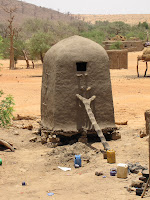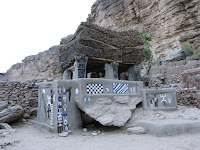The Gambia is the smallest country on mainland Africa with 1.6 million people. 90% of the people are Muslim and there are 45% of the population under 14 years of age. 40% of boys can read or write while only 20% of girls.
We arrived in Janjangbureh (Georgetown) on a minibus. The town is on Mac Carthay Island in the Gambia river. It was founded by the British in 1823, as an administrative centre and trading hub.
We were hassled by wannabe guides as soon as we stepped out of the minibus. They want to take you on river trips and show you the slave markets or take you bird watching.
We found a campement or accommodation place just outside the dusty town. A lot of the restaurants in the town were closed as it is not the main tourist season so we ate at the campement.
In the evening two Dutch women arrived in a taxi with a driver and a guide from Banjul. Bianca was travelling with her mother Carla. Carla had a lung disease and wanted to travel to Africa.
People we had met said that Janjangbureh was a nice place but we found it hot and dusty and not nice at all so decided to move on to Banjul the next day.
There was a very good road to Soma and we were lucky enough to get a seat on a new minibus. We had planned to stop the night in Soma but it was also hot and dusty and as the trip so far had been fast we decided to continue onto the cooler weather on the coast.
The minibus we transfered to was a wreck. The back door didn't close and the red dust from the road came in and covered us all. The road was in a terrible state and when it slowed down we had people hanging off the back bumper. We stopped several times to pick up men and their bicycles. The bikes went on the roof and if someone had got off the men were able to get a seat and if not they hang off the back.
The gare routiere or transport depot was on the outskirts of the city so we got a taxi to a guesthouse in the Fajara area. The guesthouse was very nice. We met some very interesting people.
Elizabeth from Netherlands was spending time with her young Gambian boyfriend. She was late 60s or early 70s and he mid twenties. The Gambia is well known as a sex tourist destination so it is not uncommon to see older women with young men. There seems to be a season when the women come from Netherland and a season when the English women come. We did meet an English guy who told us that if an English woman marries a Gambian she must stay five years in The Gambia before they can go to the UK. It seems that the men disappear once they get to the UK and head for Europe after they arrive. We haven't found anything to verify his story.
There was a woman from Cameroon who was studying in Africa and doing her medical internship here. She had been in the guesthouse for a year and although she was based in the USA her grades were not good enough to get into a medical school there so had to do her studies in Africa. She was up early in the mornings and back late at night so we rarely saw her.
We spent some time chatting with Alfred from Belgium. He had been born in the Congo and worked in South Africa. He had a van packed full of gear sent to Banjul from Belgium and was planning on setting up a patisserie business in the main street and not far from the guesthouse. He was interesting as he didn't feel comfortable in Europe and had spent a lot of time in Africa where he felt more comfortable. His wife and some of his children were going to join him later.
There were two young Dutch girls, Fleur and Wendy, doing their practicum at a school for disabled children not far from the guesthouse. They had a room and a kitchen that they could use to cook their meals everyday.
One day a guy from Guinea, Conakry, called Mouctar, cooked up some fish and fried bananas and invited everyone in the guesthouse to eat with him. Mouctar was studying in Cairo and was doing some research in Banjul. He was studying anthropology and agriculture. One day he went to the beach with a friend and as they passed the American ambassador's residence on the way to the beach they were stopped by police. Someone had burgled the residence in the night and the officers investigating the scene stopped them to check their IDs. Their documents were back at the guesthouse so the police went there to check their passports. They saw that Mouctar had a lot of books and locked him up as he didn't have the proper student's study permit. He spent some time in jail and they took away his computer after finding some information criticising the government's policies. He still hadn't got his computer back by the time we left and had already been longer than he intended in Banjul.

We were the only tourists in the guesthouse and the owners came by to say hello. The man was ill and his wife had lost interest in running the place so Alfred hopes to stay on once his patiserrie opens and manage the place with his mother-in-law. He had already worked out which of the current staff were worth retaining at the guesthouse and which ones he would like to offer a job at his patisserie. There is some construction work going on to add a third storey to the place.

The beach was deserted during the day and the only people there were the 'bumsters'. There are lots of guys in the morning and evenings running on the beach and flexing their muscles. Some are looking for women while others are selling the usual tourist wood carvings and jewelery. Some of the sellers were pretty aggressive too. The weather was a lot cooler than some of the places we have been in lately so we enjoyed the 27 degree days and did a lot of walking.
A lot of the hotels were closed along the beach but we were told that in the main tourist season they are fully booked. It was so comfortable being in an English speaking place again. We were able to find a cafe that had free Wifi and so we went there every second day to go online for the price of a soft drink and a croissant.






















































